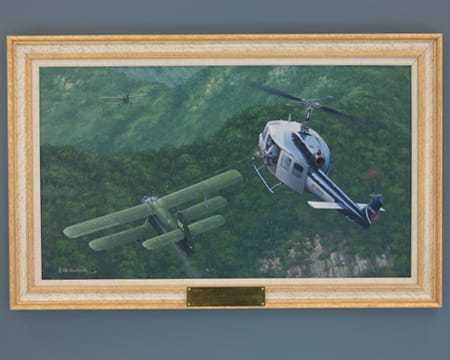Art Details

During an attack on Site 85 by the People’s Army of Vietnam, American pilot Ted Moore and flight mechanic Glenn Woods helped ward off the attack in an unarmed helicopter.
by Keith Woodcock
Oil on Canvas, 2007
Donated by Marius Burke and Boyd D. Mesecher
Known as “Site 85,” the US radar facility perched atop a 5,800-foot mountain in northeast Laos–less than 150 miles from Hanoi–was providing critical and otherwise unavailable all-weather guidance to American F-105 fighter-bombers flying strike missions against Communist supply depots, airfields, and railroad yards in North Vietnam. CIA proprietary Air America provided critical air support to the US Air Force technicians (working under civilian cover), several CIA case officers, and the CIA-directed Hmong and Thai security forces at the isolated site.
Recognizing the threat posed by this facility, the People’s Army of Vietnam vowed to destroy it. On 12 January 1968, four North Vietnamese AN-2 Colt biplanes–painted dark green and modified to drop “bombs” improvised from 122-mm mortars and 57-mm rockets–headed for Site 85.
At about 1:30 pm, as they approached their target, the four Colts split into two equal formations–one pair began low-level bombing and strafing passes while the other pair circled nearby. Coincidently, Air America pilot Ted Moore was flying an ammunition-supply run to the site in his unarmed UH-1D “Huey” helicopter when he saw the biplanes attacking. Moore and his flight mechanic Glenn Woods took chase of the first Colt. Woods pulled out his AK-47 rifle and began firing at the lumbering biplane. The pursuit was relentless, continuing for more than 20 minutes until the second Colt (hit by ground fire) joined the first in an attempt to escape back into North Vietnam. Both attacking Colts suffered severe bullet damage and crashed before reaching the border. Fearing a similar fate, the two unengaged Colts retreated unharmed.
The painting captures one North Vietnamese Colt fleeing and the other being pursued by the Air America Huey piloted by Moore as mechanic Woods fires his AK-47 at the cockpit. This daring action by Moore and Woods gained them–and Air America–the distinction of having shot down an enemy fixed-wing aircraft from a helicopterÑa singular aerial victory in the entire history of the Vietnam War.
Two months later in a night raid, North Vietnamese commandos overran Site 85 in the deadliest single ground loss of US Air Force personnel during the Vietnam War. A year later, Glenn Woods was killed in action in Laos.
On 27 July 2007, CIA officially received the painting in an event attended by members of the Air America Board; pilot Ted Moore; Sawang Reed, the wife of flight mechanic Glenn Woods; CIA paramilitary legend Bill Lair; and the donors of the painting, former Air America officers Marius Burke and Boyd D. Mesecher.
Art Specs
70 cm x 110 cm
(H x W)
